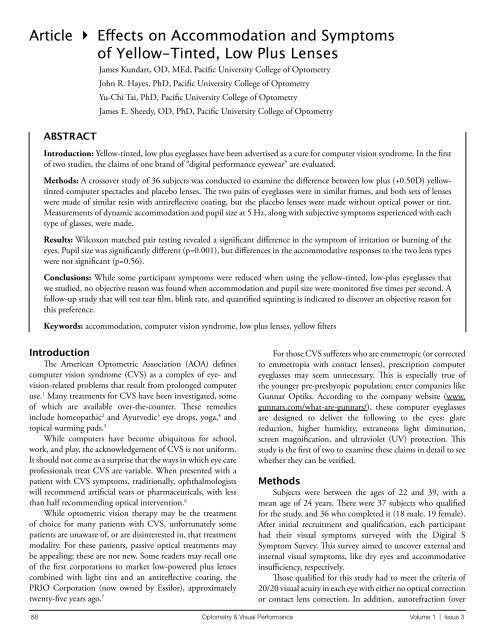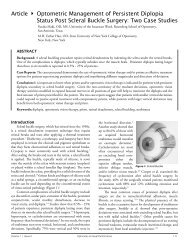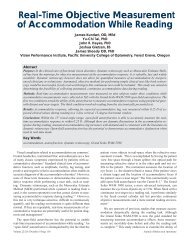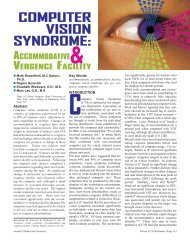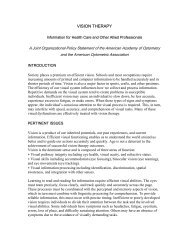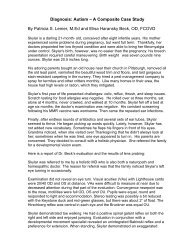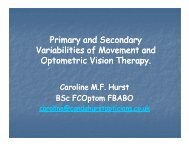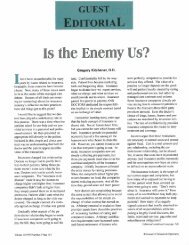Download - Optometric Extension Program Foundation
Download - Optometric Extension Program Foundation
Download - Optometric Extension Program Foundation
You also want an ePaper? Increase the reach of your titles
YUMPU automatically turns print PDFs into web optimized ePapers that Google loves.
Article 4 Effects on Accommodation and Symptoms<br />
of Yellow-Tinted, Low Plus Lenses<br />
James Kundart, OD, MEd, Pacific University College of Optometry<br />
ABSTRACT<br />
John R. Hayes, PhD, Pacific University College of Optometry<br />
Yu-Chi Tai, PhD, Pacific University College of Optometry<br />
James E. Sheedy, OD, PhD, Pacific University College of Optometry<br />
Introduction: Yellow-tinted, low plus eyeglasses have been advertised as a cure for computer vision syndrome. In the first<br />
of two studies, the claims of one brand of “digital performance eyewear” are evaluated.<br />
Methods: A crossover study of 36 subjects was conducted to examine the difference between low plus (+0.50D) yellowtinted<br />
computer spectacles and placebo lenses. The two pairs of eyeglasses were in similar frames, and both sets of lenses<br />
were made of similar resin with antireflective coating, but the placebo lenses were made without optical power or tint.<br />
Measurements of dynamic accommodation and pupil size at 5 Hz, along with subjective symptoms experienced with each<br />
type of glasses, were made.<br />
Results: Wilcoxon matched pair testing revealed a significant difference in the symptom of irritation or burning of the<br />
eyes. Pupil size was significantly different (p=0.001), but differences in the accommodative responses to the two lens types<br />
were not significant (p=0.56).<br />
Conclusions: While some participant symptoms were reduced when using the yellow-tinted, low-plus eyeglasses that<br />
we studied, no objective reason was found when accommodation and pupil size were monitored five times per second. A<br />
follow-up study that will test tear film, blink rate, and quantified squinting is indicated to discover an objective reason for<br />
this preference.<br />
Keywords: accommodation, computer vision syndrome, low plus lenses, yellow filters<br />
Introduction<br />
The American <strong>Optometric</strong> Association (AOA) defines<br />
computer vision syndrome (CVS) as a complex of eye- and<br />
vision-related problems that result from prolonged computer<br />
use. 1 Many treatments for CVS have been investigated, some<br />
of which are available over-the-counter. These remedies<br />
include homeopathic 2 and Ayurvedic 3 eye drops, yoga, 4 and<br />
topical warming pads. 5<br />
While computers have become ubiquitous for school,<br />
work, and play, the acknowledgement of CVS is not uniform.<br />
It should not come as a surprise that the ways in which eye care<br />
professionals treat CVS are variable. When presented with a<br />
patient with CVS symptoms, traditionally, ophthalmologists<br />
will recommend artificial tears or pharmaceuticals, with less<br />
than half recommending optical intervention. 6<br />
While optometric vision therapy may be the treatment<br />
of choice for many patients with CVS, unfortunately some<br />
patients are unaware of, or are disinterested in, that treatment<br />
modality. For these patients, passive optical treatments may<br />
be appealing; these are not new. Some readers may recall one<br />
of the first corporations to market low-powered plus lenses<br />
combined with light tint and an antireflective coating, the<br />
PRIO Corporation (now owned by Essilor), approximately<br />
twenty-five years ago. 7<br />
For those CVS sufferers who are emmetropic (or corrected<br />
to emmetropia with contact lenses), prescription computer<br />
eyeglasses may seem unnecessary. This is especially true of<br />
the younger pre-presbyopic population; enter companies like<br />
Gunnar Optiks. According to the company website (www.<br />
gunnars.com/what-are-gunnars/), these computer eyeglasses<br />
are designed to deliver the following to the eyes: glare<br />
reduction, higher humidity, extraneous light diminution,<br />
screen magnification, and ultraviolet (UV) protection. This<br />
study is the first of two to examine these claims in detail to see<br />
whether they can be verified.<br />
Methods<br />
Subjects were between the ages of 22 and 39, with a<br />
mean age of 24 years. There were 37 subjects who qualified<br />
for the study, and 36 who completed it (18 male, 19 female).<br />
After initial recruitment and qualification, each participant<br />
had their visual symptoms surveyed with the Digital S<br />
Symptom Survey. This survey aimed to uncover external and<br />
internal visual symptoms, like dry eyes and accommodative<br />
insufficiency, respectively.<br />
Those qualified for this study had to meet the criteria of<br />
20/20 visual acuity in each eye with either no optical correction<br />
or contact lens correction. In addition, autorefraction (over<br />
88 Optometry & Visual Performance Volume 1 | Issue 3
Figure 2: Grand Seiko WAM 5500<br />
Figure 1: Gunnar Optiks “Digital Performance Eyewear”<br />
existing refraction, if any) was performed on all participants<br />
to ensure that all refractive error was corrected to within 0.50<br />
D of emmetropia. If one or both eyes required correction, the<br />
subject had to wear contact lens until the study was complete.<br />
Participants were excluded if they had a history of long-term<br />
or continuous eyestrain but needed to use a computer at<br />
least one continuous hour per day. These criteria resulted in<br />
disqualification of three out of forty would-be participants.<br />
Of the 37 qualified subjects, most were contact lens wearers<br />
(n=29). The remaining eight participants had uncorrected<br />
visual acuity of 20/20 and nearly-emmetropic refractive error<br />
within the limits of the study.<br />
Because it was a crossover design, each subject was given<br />
either a pair of low-power (+0.50 D) spectacles with a light<br />
yellow tint, anti-reflective coating, and relatively steep (8D)<br />
base curve and face form (the Gunnar design - Figure 1), or<br />
a placebo pair of clear plano spectacles in an identical frame<br />
made with a similar coating and base curve but no tint. These<br />
were sent home with each subject to evaluate for one week, for<br />
at least one hour per day, while using a computer. Eighteen<br />
participants received the control spectacles, and the remaining<br />
nineteen received the experimental spectacles.<br />
The subjects were further instructed to complete the<br />
symptom survey online three times during the week. After<br />
a week of randomized spectacle wear, the participants were<br />
evaluated. At the first of two visits, the subjects read under one<br />
of the following conditions for five minutes each:<br />
• With five 15W compact fluorescent lights, causing<br />
300W equivalent glare. These lights have a color<br />
temperature of 6500 K.<br />
• With low (about 5%) contrast text.<br />
• With control text (12-point, full contrast).<br />
Each condition was tested in Latin square order while<br />
the research subject read an electronic book with either<br />
placebo glasses or yellow-tinted, low-power computer glasses<br />
(the Gunnar design). During reading, participants had their<br />
accommodation measured with the Grand Seiko WAM-5500<br />
open-field autorefractor (Figure 2). Although the autorefractor<br />
has no way of “knowing” that it is not measuring refractive<br />
error, with this type of open-field model, a reading rod can<br />
be used, and if the patient is corrected to emmetropia, the<br />
accommodative response can easily be calculated so long as<br />
working distance is known. For the purpose of this study, a 40<br />
cm working distance on the reading rod was used (Figure 3).<br />
Volume 1 | Issue 3 Optometry & Visual Performance 89
Figure 4: Frequency of Internal Symptoms<br />
Figure 3: Setup for reading text with pull-down pages on the openfield<br />
autorefractor.<br />
The WAM-5500 has a dynamic mode in which both the<br />
accommodative response and pupil size are obtained at 5 Hz<br />
and automatically recorded to an Excel spreadsheet via a serial<br />
computer cable. Measurement of accommodation and pupil<br />
size while reading continuous text (rather than fixating at a<br />
single letter or line on a reduced Snellen chart) has been shown<br />
to be reliable in previous studies by the Vision Performance<br />
Institute. 8 After each condition, the Digital Symptom Survey<br />
was administered, for a total of three times each visit.<br />
After these in-lab measurements were made at the end<br />
of the first week, the subjects turned in their first pair of<br />
experimental spectacles and were given the other type of<br />
eyeglasses (placebo versus low-power spectacles with a light<br />
tint) for one additional week. During each week of home<br />
study, the symptom survey was administered online three<br />
times, asking the participants about their experience while<br />
using the glasses on the computer.<br />
After the second week of spectacle wear, one additional<br />
visit was scheduled to evaluate the same three conditions as<br />
the first visit (glare, low contrast, and control). At this visit,<br />
both pairs of spectacles were given to the subjects to choose,<br />
so that they were able to keep their preference. Preference exit<br />
surveys were administered to close the study.<br />
Each subject’s most severe symptom was noted among the<br />
three conditions presented in-lab. Differences between glasses<br />
for each of the 23 symptoms was analyzed separately with a<br />
Wilcoxon matched pair test. Subjects expressing a symptom<br />
level of moderate or greater were noted as having a symptom.<br />
Mild or no symptoms were defined as no symptoms. The<br />
percentages of subjects expressing each symptom are provided<br />
in Figures 4, 5, and 6.<br />
Results<br />
Twenty-three symptoms were surveyed both in-office and<br />
at home. Dividing the subjective surveys into those caused by<br />
external factors, such as glare and dryness, and those caused<br />
by internal factors, such as blur and double vision, some<br />
statistically significant differences were found. This analysis<br />
Figure 5: Frequency of External Symptoms<br />
Figure 6: Frequency of Miscellaneous Symptoms<br />
and the analysis of the symptom scores were by mixed model<br />
analysis of variance with condition and type of glasses.<br />
Survey Results<br />
In the Digital Symptom Survey, participants were asked<br />
if they experienced mild, moderate, severe, or very severe<br />
symptoms, if any at all, in each of 23 categories. Figures<br />
4, 5, and 6 show the percentage of the subjects expressing<br />
symptoms in each of the experimental conditions. The vast<br />
majority of participants responded that they had none of these<br />
symptoms, with the mode of their responses showing a zero<br />
response. Of the 23 symptoms, only the number of subjects<br />
reporting eye irritation was significantly greater for placebo<br />
90 Optometry & Visual Performance Volume 1 | Issue 3
than tinted glasses (p=.04). There was essentially no difference<br />
between the types of glasses with respect to symptom scores.<br />
Lastly, in the exit survey, 22 of 37 (59%) subjects preferred<br />
the yellow-tinted magnifying glasses (the Gunnar design)<br />
compared with no lenses (41%) in a forced choice. However,<br />
the subjects also admitted to wearing their glasses for less than<br />
one hour a day on their computers, despite computer use of<br />
4-12 hours per day. This can be most likely explained by the<br />
fact that these subjects were recruited from those least likely to<br />
wear corrective spectacles. Those who needed correction had<br />
chosen to wear contact lenses, in many cases to avoid using<br />
spectacles in the first place.<br />
Accommodation Results<br />
Objective data were also obtained using the Grand Seiko<br />
WAM 5500 open-field autorefractor. In dynamic mode, this<br />
instrument is capable of capturing accommodative and pupil<br />
data up to five times per second (5 Hz) while the participant<br />
reads on a reading rod.The results were as follows:<br />
Table 1: Accommodation<br />
Accommodation Gunnar Lenses Placebo Lenses<br />
Mean (Diopters) 1.092 0.675<br />
Standard Error (Diopters) 0.156 0.158<br />
Difference 61.940 63.673<br />
Lower Bound 0.780 0.359<br />
Upper Bound 1.404 0.990<br />
1. For the dependent variable, the spherical equivalent<br />
accommodative response mean, there was no<br />
statistically significant difference (p=0.56). This was<br />
determined by mixed model analysis of variance with<br />
condition and type of glasses. However, there was a<br />
clinically significant difference of approximately 0.40<br />
D (Table 1). This accommodative response mean<br />
reveals a lag of accommodation, which was typically<br />
0.50 D less than the near demand of 2.50 D for the<br />
40 cm working distance used on the Grand Seiko<br />
reading rod. It is also interesting to note the stability of<br />
accommodation, as measured five times per second by<br />
the open-field autorefractor.<br />
2. For the dependent variable, pupil size, there was a<br />
significant difference (p
the purpose of our follow-up study, in which the base curve<br />
and face form wrap of the Gunnar design is investigated<br />
using Zone-quick phenol-red thread testing for dry eye and<br />
electromyography of the orbicularis to quantify squinting.<br />
Perhaps this follow-up study can help explain why 22 of 37<br />
(59%) participants still preferred the Gunnar design when<br />
given the forced choice between yellow lenses and none. This<br />
was true despite less than one hour per day of self-reported<br />
compliance in wearing them during a minimum of four hours<br />
per day of self-reported computer use.<br />
Conclusions and Recommendations<br />
The Gunnar Optiks glasses reduced external symptoms of<br />
irritation or burning of the eyes. They also affected pupil size,<br />
but not accommodation or other subjective symptoms.<br />
Compliance with either pair of computer spectacles was<br />
generally less than one hour a day, even among those who<br />
worked on computers at least four hours a day. Compliance<br />
could potentially be increased by making prescription Gunnar<br />
Optiks available to regular spectacle wearers, those who are<br />
accustomed to eyeglass wear and therefore are more likely to<br />
wear them.<br />
In light of the two differences between the Gunnar<br />
Optiks and placebo glasses, namely the optical power and<br />
tint, further research is indicated to explore the following:<br />
1. Why are the external symptoms of irritation and<br />
burning subjectively different when the curvature of<br />
the lenses and frames was the same in the two types of<br />
eyeglasses?<br />
2. The effects of these two types of eyeglasses on squinting<br />
have not been explored. It can be investigated with<br />
electromyography (EMG) of the eyelid.<br />
3. Objective measurement of dry eye and blink rate has<br />
not been explored, but should be examined using an<br />
objective measurement of tear volume and different<br />
base curves from the Gunnar design, perhaps under a<br />
stressor condition such as forced air cooling, as many<br />
computer users experience.<br />
Acknowledgements<br />
The authors would like to thank the following people for<br />
their contributions to this project: Ariene Clark, OD, MS;<br />
Vinsunt “Sunny” Domato; David Glabe, OD, MS; Alexandra<br />
Ifrim, BS; Dewey Kim, BS; Brittany Nelson, OD.<br />
References<br />
1. AOA.org. St. Louis: American <strong>Optometric</strong> Association; c 2006-12 [cited 2012<br />
Jul 8]. Available from: http://www.aoa.org/x5253.xml.<br />
2. Computer Eye Relief from SimilasanUSA.com. Highlands Ranch, CO: Similasan<br />
USA; c 2010-11 [cited 2012 Jul 8]. Available from http://bit.ly/14HW4bd.<br />
3. Gangamma MP, Poonam, Rajagopala M. A clinical study on “computer<br />
vision syndrome” and its management with Triphala eye drops and Saptamrita<br />
Lauha. Ayu: An International Quarterly Journal of Research in Ayurveda<br />
2010;31(2):236-9. PMID: 22131717. Available from http://bit.ly/16tZxq5.<br />
4. Telles S, Naveen KV, Dash M, Deginal R, et al. Effect of yoga on self-rated visual<br />
discomfort in computer users. Head Face Med 2006;2:46. PMID: 17140457.<br />
Available from: http://1.usa.gov/10COffW.<br />
5. Ilango K. Warming device for computer vision syndrome. Indian J Ophthalmol<br />
[serial online] 2008;56:171. Available from: http://bit.ly/XsyCN1<br />
6. Bali J, Navin N, Thakur BR. Computer vision syndrome: A study of the knowledge,<br />
attitudes and practices in Indian Ophthalmologists. Indian J Ophthalmol<br />
[serial online] 2007;55:289-93. Available from: http://bit.ly/12nka6S.<br />
7. Prio.com. Dallas: copyright Essilor Corporation [cited 2012 Jul 8]. Available<br />
from: http://www.prio.com/.<br />
8. Kundart J, Tai YC, Hayes JR, Gietzen J, et al. Real-Time Objective Measurement<br />
of Accommodation While Reading. J Behav Optom 22:5;168-75.<br />
Correspondence regarding this article should be emailed to kundart@<br />
pacificu.edu or sent to James Kundart, OD, MEd, FAAO, Pacific<br />
University College of Optometry, 2043 College Way, UC Box A-134,<br />
Forest Grove, OR 97116-1797, Tel: 503-352-2759. All statements<br />
are the authors’ personal opinions and may not reflect the opinions of the<br />
representative organizations, ACBO, COVD, or OEPF, Optometry & Visual<br />
Performance, or any institution or organization with which the author may be<br />
affiliated. Permission to use reprints of this article must be obtained from the<br />
editor. Copyright 2013 <strong>Optometric</strong> <strong>Extension</strong> <strong>Program</strong> <strong>Foundation</strong>. Online<br />
access is available at www.acbo.org.au, www.covd.org, and www.oepf.org.<br />
Kundart J, Hayes J, Tai Y, Sheedy J. Effects on accommodation<br />
and symptoms of yellow-tinted, low plus lenses. Optom Vis Perf<br />
2013;1(3):88-92.<br />
Financial Disclosure: This study was supported by a grant from<br />
Gunnar Optiks.<br />
The online version of this article<br />
contains digital enhancements.<br />
92 Optometry & Visual Performance Volume 1 | Issue 3


